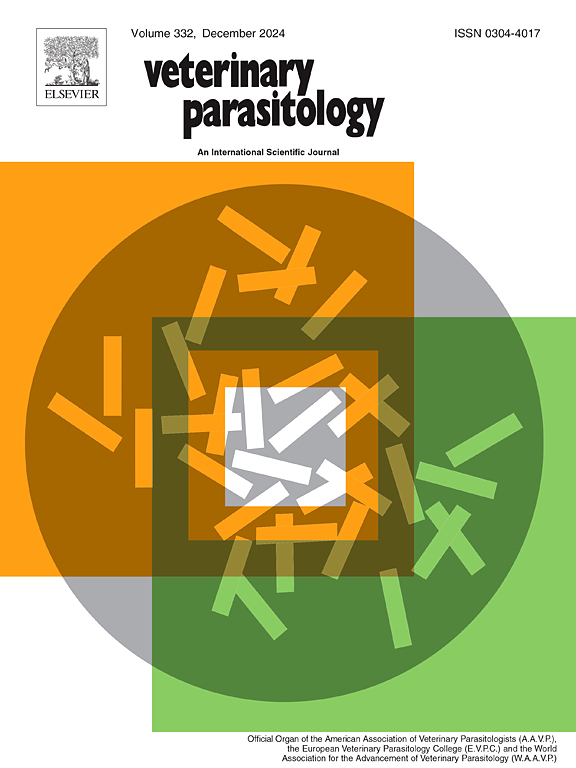三种绵羊胃肠道线虫在不同低温保存策略下体外和体内复活成功率的比较
IF 2
2区 农林科学
Q2 PARASITOLOGY
引用次数: 0
摘要
具有兽医重要性的线虫感染幼虫(L3)已在液氮(LN2)中低温保存,以尽量减少继续通过活体动物的需要。考虑到健康和安全问题,加上降低运行和维护成本的压力越来越大,促使人们需要探索其他保存技术。超低温(-150°C)冷冻机已用于细胞系的长期储存,但尚未有关于家畜胃肠道线虫(GIN)的公开数据。采用三种低温保存方法,对三种GIN种(环皮绒球绦虫(MTci2)、色状毛线虫(MTco1)和弯曲血蜱(MHco3和MHco18) L3的体外和体内存活能力进行了评估。简而言之,5万只幼虫被挖出来,用三种方法中的一种冷冻保存;在-150°C (LN/-150°C)下储存前在LN2中快速冷冻;直接在- 150°C下保存或在LN2 (LN)中保存。在-150°C和LN/-150°C储存后约1、2、4、6、11和23个月,评估L3的体外存活能力(死与活)。将幼虫解冻后置于PBS中,在39.6°C和10 % CO2条件下过夜,然后进行死/活评估。L3在储存4个月后进行了体内研究。直接保存在- 150°C的试管中,所有分离株的体外存活率一致显示≥ 90 %,而LN/ - 150°C显示种间差异(存活率范围:7-63 %)。体内评估结果显示,在LN/ - 150°C条件下,整个组的平均成活率从9 %到62 %不等,其中- 150°C和LN组的成活率分别为25 %和10 %。本文章由计算机程序翻译,如有差异,请以英文原文为准。
Comparison of in vitro and in vivo resurrection success of three ovine gastrointestinal nematode species following different cryopreservation strategies
Nematode infective larvae (L3) of veterinary importance have been cryopreserved in liquid nitrogen (LN2) to minimize the need for continued passage through live animals. Health and safety concerns, combined with increasing pressures to reduce running and maintenance costs have driven the need to explore alternative preservation techniques. Super-cold (-150°C) freezers have been used for long term storage of cell lines, but no published data were available for livestock gastro-intestinal nematodes (GIN). In vitro and in vivo survivability of L3 of three GIN species (Teladorsagia circumcincta (MTci2), Trichostrongylus colubriformis (MTco1) and Haemonchus contortus (MHco3 and MHco18)) were assessed following three cryopreservation storage methods. In brief, fifty thousand larvae were exsheathed, and cryopreserved using one of three methods; either snap frozen in LN2 before storage at −150 °C (LN/-150°C); stored directly at −150°C or stored in LN2 (LN). In vitro survivability of L3 (dead versus alive) were assessed at approximately 1, 2, 4, 6, 11 and 23 months post −150°C and LN/-150°C storage. Larvae were defrosted and left in PBS overnight at 39.6°C and 10 % CO2 prior to dead/alive assessment. An in vivo study was undertaken with L3 following 4 months of storage. The tubes stored directly in −150°C have consistently shown ≥ 90 % in vitro survivability for all isolates, whereas LN/−150°C showed inter species variability (range: 7–63 % survivability). The in vivo assessment demonstrated a significant difference in establishment with overall group mean establishment ranging from 9 % in the LN/−150°C to 62 % of the fresh larvae, with the −150°C and LN groups establishing 25 % and 10 % respectively.
求助全文
通过发布文献求助,成功后即可免费获取论文全文。
去求助
来源期刊

Veterinary parasitology
农林科学-寄生虫学
CiteScore
5.30
自引率
7.70%
发文量
126
审稿时长
36 days
期刊介绍:
The journal Veterinary Parasitology has an open access mirror journal,Veterinary Parasitology: X, sharing the same aims and scope, editorial team, submission system and rigorous peer review.
This journal is concerned with those aspects of helminthology, protozoology and entomology which are of interest to animal health investigators, veterinary practitioners and others with a special interest in parasitology. Papers of the highest quality dealing with all aspects of disease prevention, pathology, treatment, epidemiology, and control of parasites in all domesticated animals, fall within the scope of the journal. Papers of geographically limited (local) interest which are not of interest to an international audience will not be accepted. Authors who submit papers based on local data will need to indicate why their paper is relevant to a broader readership.
Parasitological studies on laboratory animals fall within the scope of the journal only if they provide a reasonably close model of a disease of domestic animals. Additionally the journal will consider papers relating to wildlife species where they may act as disease reservoirs to domestic animals, or as a zoonotic reservoir. Case studies considered to be unique or of specific interest to the journal, will also be considered on occasions at the Editors'' discretion. Papers dealing exclusively with the taxonomy of parasites do not fall within the scope of the journal.
 求助内容:
求助内容: 应助结果提醒方式:
应助结果提醒方式:


